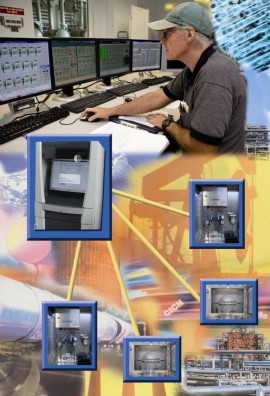
Continuous control of quality parameters is essential to ensure the formation of in-spec products throughout their entire production process. It is a common practice in the oil and gas business not to rely on the measurement of one single physical property of a process stream to guarantee the quality of the product. In general, the quality of a petroleum product comprises the quantification of various different physical properties that should all conform to their product specification.
Adequate process control requires the availability of real-time physical properties and chemical composition of products to ensure their quality parameters conform to specifications. To achieve this, refineries incorporate on-line process analyzers that provide the required data to the DCS.
Types of Process Analyzers
Process analyzers are divided into two groups:
- Conventional ASTM analyzers perform measurements exactly according to ASTM methods. These analyzers and analytical methods are usually similar to methods applied in the laboratory so the results are expected to be fully equivalent to laboratory tests.
- Correlative analyzers indirectly quantify a physical property by correlation of physical-chemical properties with spectral measurements, such as NIR, NMR, FTIR, and Raman, and by using chemometrics.
Differences Between Conventional and Correlative Analyzers
The main difference between these analyzers is that conventional ASTM analyzers provide analytical data, which actually does not need to be further validated with laboratory measurements since both use the same analytical methods and should give the same result.
Correlative analyzers operate differently. They do not measure chemical or physical properties according to well-defined procedures but use mathematics and algorithms to correlate the spectrum and different physical properties of a chemical composition. This relates to the effect that overall physical properties and the spectral pattern are the result of the contribution of each individual compound that is present in a chemical composition in a process stream.
Remote Sensor Technology (RST) in Oil and Gas Industries
Oil and gas industries are spread over large territories. The concept of remote sensor technology (RST) bridges the need for process units to measure inside the hazardous zones and the requirement that analyzers that are placed in that area must be enclosed in specially approved analyzer housings or shelters.
Remote Process Analytics (RPA)
Remote process analytics (RPA) provides a solution for safe and accurate measurement of physical properties in Ex-Zone areas by using an NIR process analyzer-based system. The concept of this technology allows the analyzer to be connected by standard telecommunications fiber optics to a multiple
set of different field units. These field units are installed at a distance of up to 3 km from the analyzer, close to the process. The measuring probes are free of electricity, without moving parts, and without any material able to generate static electricity.
Integration of AI in Process Analysis
A major strategy in achieving the goal in oil and gas industries is to effectively utilize analyzers hardware and AI software solutions. AI enables to calculate and predict physical properties and chemical compositions for different process streams and proposes required set points, that will accomplish the calculated predictions. Integration of these technologies will afford a tool that allows the simulated digital twin to continuously be updated to allow the highest possible efficiency of the process at the lowest cost.
Using modern AI tools powered by accurate KPI measurement forms a basic tool for managers to operators to make the correct decisions to maintain and improve effective industrial process management.






